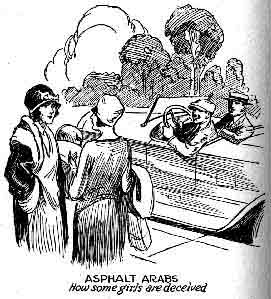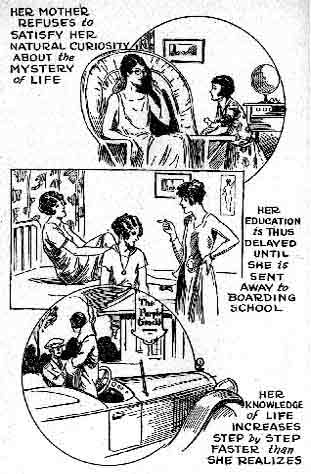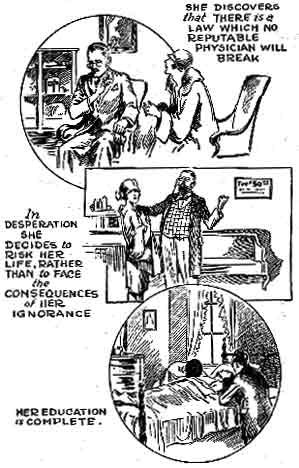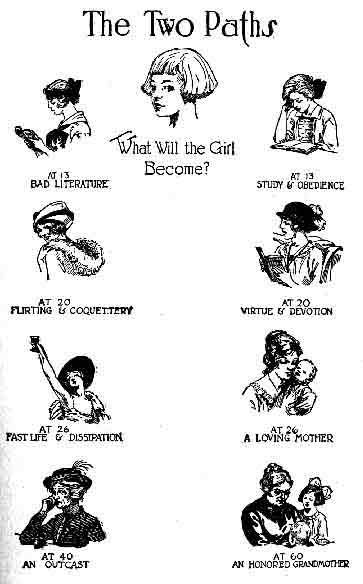Other sex-education books: Married
Love (1931), by Dr. Marie Stopes; Sex Facts for
Women (1936), by Richard J. Lambert; and see Miscellaneous
topics on this site
Marjorie May, three booklets, 1935 main page
 
|
 
THE MUSEUM OF MENSTRUATION AND WOMEN'S HEALTH: BIRTH CONTROL, MOTHERHOOD
Safe Counsel /or/ Practical Eugenics
by B. G. Jeffries, M.D., Ph.D., J. L. Nichols,
A.M., Ozora S. Davis, Ph.D., and Dr. Emma F. A. Drake (39th edition, 1928,
J. L. Nichols & Co., Naperville, Illinois, U.S.A.)
Sir Francis Galton (1822-1911), a cousin of Charles Darwin, introduced
the word eugenics and probably founded the
eugenics movement.
In a preface to this book, "The Science of Eugenics," the
authors write:
"Eugenics, to use the definition of Sir Francis Galton, is the
science which deals with all the influences that improve the inborn qualities
of a race. It has also been called the science of improving the human race
by better breeding."
Many people think of Hitler's attempt to create a "pure" race
when they think of eugenics, but the dictator got some of his ideas from
the American eugenics movement, which was behind the forcible sterilization
of some Americans with "unacceptable" qualities, such as mental
retardation. In 1936, the University of Heidelberg, in Germany, awarded
American biologist Harry Laughlin, the creator of Virginia's eugenics laws,
an honorary doctorate. Hitler used Virginia's laws as the model for his
similar law ("Gesetz zur Verhütung erbkranken Nachwuchses").
Laughlin would have "preferred to immediately castrate the most worthless
tenth of the population," according to the quotation of the German
news magazine Der Spiegel (issue #13, 2000).
Read two excerpts from this extraordinary book:
In the first place in all such cases of feeble-mindedness,
epilepsy, degeneracy [could this mean homosexuality, masturbation, "unusual"
religious beliefs such as Wicca, Satanism - or Islam, Mormonism, the Quakers,
Catholicism, or that of the person next door you don't like?] pauperism
and congenital criminality, the patients should be freely given information
as to the means for the prevention of conception. If they maliciously refuse
to make use of contraceptives and continue to propagate their kind, then
the state certainly has the right to step in and make it impossible to
bring children into the world that they may become a menace to public health
and a public burden. For the state to fail in either of these preventative
measures is simply to follow the surest road to national degeneracy.
. . . .
STERILIZATION OF DEFECTIVES LEGAL
The Virginia [s]tate [l]aw providing for the sterilization of mental defectives
has recently been upheld by the United States Supreme [C]ourt in an opinion
deemed of much importance because of the agitation for similar legislation
in other states.
Better [f]or [a]ll [w]orld. The majority of the court, in the opinion written
by Mr. Justice Holmes, held "that it is better for the world, if,
instead of waiting to execute degenerate offspring for crime, or to let
them starve for their imbecility, society can prevent those who are manifestly
unfit from continuing their kind."
|
This large book (512 pages) was in many ways highly moral and public
spirited, and claimed sales of more than one million copies on the back
of the title page. It advised the reader on contraception, of course (and
if the reader was defective, to use it!); the prevention of disease, venereal
and otherwise; raising children; sex education; finding a mate; advice to
newlyweds; maternal care; etc.
Men were advised to be tall and strong,
women to have little feet. In particular,
"All women despise soft and silly men more than all other defects in
their character. Woman [sic] can never love a man whose conversation is
flat and insipid. . . . Young man, if you desire to win the love and admiration
of young ladies, first, be intelligent; remember what you read, so you can
talk about it."
(For example, this Web site: Ask that cutie you're trying to meet on the
subway what she uses, a question close to her heart. "'Pons or pads?"
you ask, then wink, and, turning serious, ask if she's tried interlabial
pads. "Here," you say, "I happen to have an extra box
in my backpack." What? She's pulling the emergency brake and
is screaming for the police? Obviously she's not your type. Go to
the Anti-tampon Conference in Harrisonburg, Virginia, on 1-2 April, discussed
on the 27 March 2000 News page.)
Below: see some of the volume's beautiful pen-and-ink drawings, typical
of the time.
SarahAnne Hazlewood generously donated this book to the museum.
|


|
 |
The name of the roadhouse in the lower picture is The Purple
Grackle, purple having probably a bad connotation ("purple prose").
|
The middle drawing shows an abortionist - abortion was illegal
- charging $50.
|

|







